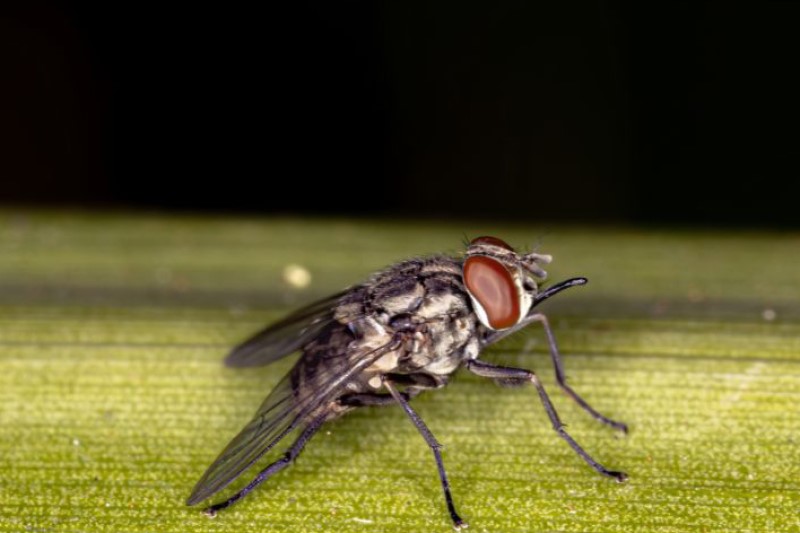Biting flies spreading mastitis: new route of transmission

Previous studies have linked stable flies to bovine mastitis, but most have focused on mechanical transmission by looking at pathogens that can stick to a fly’s body or legs. The new work points to insect bites as an additional route of transmission, researchers at the University of Wisconsin-Madison in the US found.
The research may point to new strategies for protecting cows from disease-causing pathogens. As treatment of many environmental mastitis pathogens is often viewed as ineffective and infection dynamics are primarily host-driven, there is a need for a deeper comprehension of pathogen ecology, management strategies, and epidemiology to mitigate the disease burden.
Improved management would have great benefits for dairy farmers who have problems with mastitis. Not only does low-quality milk need to be discarded, but dairy farmers must also pay for costs associated with lost labour, as well as the treatment and potential culling of sick cows. The economic losses associated with mastitis cases are especially burdensome, costing the global dairy industry an estimated US$35 billion annually.
Bovine mastitis, which affects cows, leads to reduced milk production and can be fatal if left untreated. The USDA National Animal Health Monitoring System has reported cases in 99.7% of all dairy operations in the US, making it the most prevalent disease on dairy farms.
Pathogenic bacteria and other microbes cause the condition, though the exact mechanisms of transmission – especially by flies, which are known to potentially play a role in many dairy farm diseases – haven’t been elucidated.
Pathogenic microbes
A study recently published in mSphere, a journal of the American Society for Microbiology, has identified Stomoxys flies (also known as stable flies) as carriers of pathogenic bacteria that cause bovine mastitis. Researchers at the University of Wisconsin-Madison sequenced microbial communities from these biting flies at 2 connected dairy farms, then compared those findings to manure samples from the same farms. In both samples they identified bacterial taxa associated with bovine mastitis.
Notably, the researchers found that the pathogenic microbes, which included colonies of Escherichia, Klebsiella and Staphylococcus bacteria, were fairly rare and scattered in the manure samples. In the fly samples, however, those same species showed dramatically higher abundance. That mismatch strongly suggests that the pathogenic bacteria readily colonise and persist in the fly gut.
It seems there is an enrichment of specific manure-associated bacterial strains within the Stomoxys fly internal environment. These fly microbial communities included multiple taxa (Staphylococcus, Pseudomonas, Enterococcus, and Enterobacterales) associated with environmental bovine mastitis. The high abundance of mastitis-associated lineages could be driven by physiological conditions within the digestive tract of the flies (pH, nutrient availability, etc.).
Insect bites as an additional route
According to microbiologist and senior author Kerri Coon, Ph.D., whose lab focuses on disease vectors and insect-microbe interactions, the flies are bona fide reservoirs of these bacteria. “Their gut is not only permissive to colonisation by clinically relevant groups of bacteria, but these bacteria are also able to grow and multiply to become dominant members of the fly microbiome,” Coon emphasises. The stable flies, she says, may actually be helping to maintain these pathogens in the environment.
Previous studies have linked stable flies to bovine mastitis, Coon points out, but most have focused on mechanical transmission by looking at pathogens that can stick to a fly’s body or legs and be transmitted when a fly lands on an open sore or opening in the cow’s body.
The new work, she says, points to insect bites as an additional route of transmission. When a stable fly bites a cow, it injects salivary proteins that help it access and digest blood. That process offers an opportunity for the pathogens to pass from the fly’s microbiome to the cow’s body.
Bacterial taxa associated with mastitis
Using high-throughput 16s rRNA sequencing, a method often used to identify and compare bacteria, Andrew Sommer and Julia Kettner – both graduate students in Coon’s lab – analysed internal samples from a total of 697 flies and compared those to data from 106 manure samples, all collected from 2 dairy farms in southern Wisconsin.
The manure samples showed a significantly higher diversity of bacterial species than the fly samples, but bacterial taxa associated with mastitis were found in much higher abundances in the matched fly samples.
“We know manure acts as a reservoir of pathogens, but they’re pretty patchy, and environmental or opportunistic pathogens are generally at low abundance,” Coon explains. “So, when a cow gets an opportunistic or environmental kind of bovine mastitis infection, we want to know how it got there.”
In previous work, Coon investigated the role of insect-microbiome interactions in mosquitoes. She launched the new study with support from the University of Wisconsin Dairy Innovation Hub, which brings together dairy farmers and researchers to support the state’s dairy industry.
In addition to implicating the microbiome of biting flies as a reservoir for pathogens, the new work may help guide better strategies for protecting cows from bovine mastitis – and even for protecting people from possible zoonotic infections.
Novel insights
“I think there’s a lot of excitement about tapping these insect microbiomes as a resource for preventive or protective strategies on dairy farms,” Coon says. “But first we have to understand the fundamental processes underlying how these insects and microbes behave, and potentially contribute to disease transmission, in the field.”
Future work will elucidate the role of biting flies in the transmission of not only bovine mastitis pathogens, but other farm-associated zoonotic pathogens including E. coli O157, Brucella, and Salmonella.
Future work will also leverage these results to provide novel insights into the ecology and evolution of these and other dipteran insects more broadly, including species that serve important roles as bioindicators, biocontrol agents, sources of nutrition for other organisms, nuisance pests, as well as other vectors of disease.
Join 13,000+ subscribers
Subscribe to our newsletter to stay updated about all the need-to-know content in the dairy sector, two times a week.










